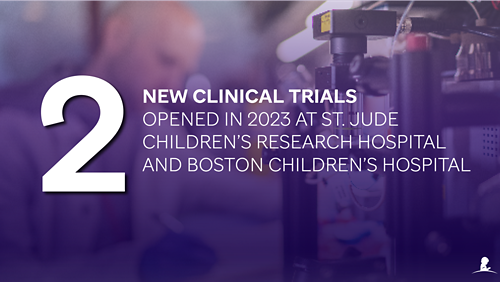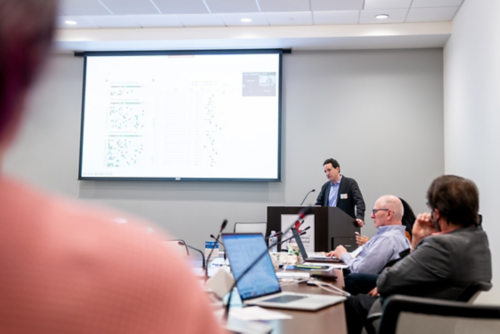St. Jude Family of Websites
Explore our cutting edge research, world-class patient care, career opportunities and more.
St. Jude Children's Research Hospital Home

- Fundraising
St. Jude Family of Websites
Explore our cutting edge research, world-class patient care, career opportunities and more.
St. Jude Children's Research Hospital Home

- Fundraising
About the collaborative
St. Jude established the Collaborative Research Consortium for Sickle Cell Disease (CRC-SCD) in 2018 with the goal of advancing treatments for this devastating genetic disease. Sickle cell disease (SCD) is an inherited red blood cell disorder affecting over 100,000 Americans and millions worldwide. The St. Jude Hematology Clinic cares for approximately 900 children with SCD.
The molecular hallmark of this chronic multisystem disorder is abnormal hemoglobin. Early in development, fetal hemoglobin is produced and comprises two α-like globin peptides and two γ-like globin peptides. Around birth, fetal hemoglobin is gradually replaced with adult hemoglobin, which is normally composed of two α-like globin peptides and two ß-like globin peptides. Autosomal recessive mutations in the HBB gene, which encodes the ß-globin subunit of adult hemoglobin, cause SCD. Hence, the disease becomes symptomatic over the first six months of life, coincident with the switch from normal fetal hemoglobin to mutant adult-type sickle hemoglobin. At low oxygen concentrations found in small blood vessels, sickle hemoglobin forms stiff polymers, causing red blood cells to become sickle shaped, brittle and sticky. This results in numerous clinical problems including anemia, severe pain, progressive multi-organ damage and early mortality. There have been advances in managing SCD, but many patients still experience major medical problems and early death. The CRC-SCD is addressing the need for novel SCD treatments that can be administered safely before organ damage occurs. Over the past five years, CRC-SCD scientists have published 42 peer-reviewed manuscripts in high profile journals including Nature, Nature Medicine, Nature Biotechnology and Nature Biomedical Research. This work has supported more than $3 million in external grant funding.
Elevated levels of fetal hemoglobin (HbF) in SCD patient red blood cells can decrease symptoms, reduce organ damage and prolong life.

The CRC-SCD made significant preclinical advances in therapeutic induction of HbF by furthering the mechanistic understanding of the γ-to-ß-globin gene switch and inhibiting this switch through novel genome-editing strategies.
These groundbreaking discoveries are supporting clinical trials planned to open in 2023 at Boston Children’s Hospital and St. Jude Children’s Research Hospital. Work by the CRC-SCD also focused on mechanisms of globin gene regulation, leading to the discovery of several regulatory elements that control HbF expression and serve as potential therapeutic targets.

The CRC-SCD also adapted newly developed genome strategies to treat SCD. CRC researchers created base editors — modified types of Cas9 protein fused to a nucleotide deaminase. This gene-editing technique creates more precise genetic changes and bypasses some potential safety risks associated with Cas9 nuclease editing. CRC-SCD researchers used base editing to successfully edit the SCD-mutated HBB gene, reduce the production of pathological sickle ß-globin subunits and alleviate SCD pathologies in patient-derived cells and in a mouse model. In addition, CRC-SCD researchers used base editors to generate de novo transcription factor binding motifs in the γ-globin promoter that robustly induced HbF — a strategy being considered for future clinical trials. CRC-SCD investigators also developed prime editing, a strategy for fusing a modified Cas9 protein to a reverse transcriptase. Combined with a CRC-developed machine learning-based tool that optimizes the design of prime editors, this technology provides a powerful new strategy for correcting SCD mutations. The CRC-SCD is also developing sensitive new methods to detect genome editing-related genotoxicities and identifying more effective approaches to mobilize hematopoietic stem cells (HSCs) from SCD patients undergoing gene therapy.
The CRC-SCD was renewed in 2022 and is researching the regulatory circuitry controlling HbF expression, identifying new ways to perform gene editing in HSCs and testing various gene-editing strategies in humanized mouse models for ß-hemoglobinopathies. The discoveries made will advance treatment options for SCD and optimize the next generation of genome-editing strategies that can be utilized for ß-hemoglobinopathies and potentially many other genetic disorders.
Collaborative members
Lead - Mitchell J. Weiss, PhD, St. Jude Children’s Research Hospital
Daniel E. Bauer, Boston Children’s Hospital/Harvard Medical School
Gerd A. Blobel, Children’s Hospital of Philadelphia and the Perelman School of Medicine at the University of Pennsylvania
Yong Cheng, PhD, St. Jude Children’s Research Hospital
David R. Liu, Harvard University/Broad Institute of Harvard and MIT
Shondra M. Pruett-Miller, PhD, St. Jude Children’s Research Hospital
Junwei Shi, Perelman School of Medicine at the University of Pennsylvania
John Tisdale, NIH/National Heart, Lung, and Blood Institute
Shengdar Q. Tsai, PhD, St. Jude Children’s Research Hospital
Jonathan S. Yen, PhD, St. Jude Children’s Research Hospital